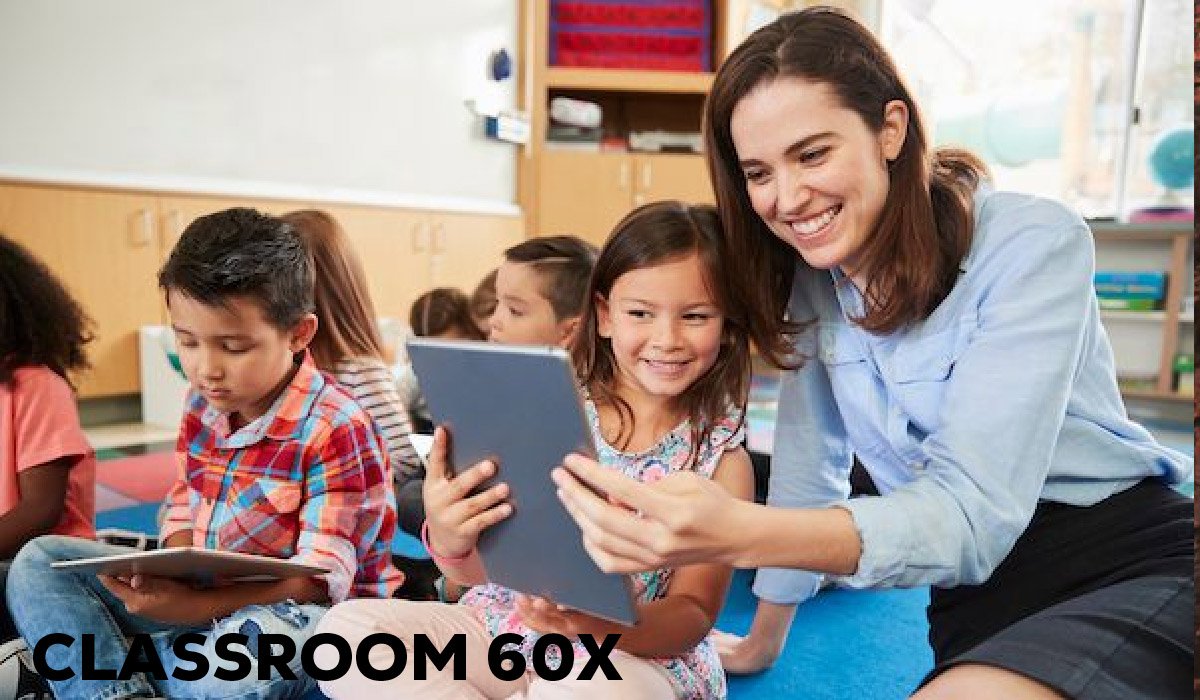Blog
Classroom 60x: A Powerful Future-Ready Model Transforming Education

What if classrooms were no longer rigid spaces defined by rows of desks and chalkboards, but instead transformed into living systems that adapt to the needs of every student? This is the central vision behind classroom 60x, a revolutionary model that reimagines the role of learning spaces in modern education. Rather than treating the classroom as a static environment, the 60x approach positions it as a dynamic, flexible, and interactive hub where technology, collaboration, creativity, and real-world experiences converge.
At its heart, classroom 60x challenges the long-standing limitations of traditional teaching and promises to create an environment where students are not just listeners, but active participants in shaping their own learning journey. By combining flexible design, immersive tools, and new teaching philosophies, classroom 60x sets the stage for the future of education.
Breaking Down the “60x” Idea
The term classroom 60x carries layered meaning, and while interpretations may vary, the underlying idea remains powerful. For some, the “60x” suggests the multiplier effect that such a model can have on learning outcomes—students can potentially learn and retain knowledge at several times the efficiency compared to conventional classrooms. For others, it refers to classroom sizes or even the ideal of sixty minutes of meaningful, active engagement within a learning session.
Regardless of how the term is defined, classroom 60x symbolizes a bold shift from passive, lecture-heavy education to dynamic, student-centered approaches. Unlike rigid frameworks that dictate a one-size-fits-all method, classroom 60x functions as a flexible system that schools and institutions around the world can adapt according to their resources, goals, and cultural contexts. This versatility makes it an innovative framework that can thrive in diverse educational settings.
The Pillars of Classroom 60x
At the foundation of classroom 60x are four essential principles that guide its design and implementation. The first is space flexibility, which emphasizes reconfigurable layouts, movable furniture, and student-centered zones that allow classrooms to shift seamlessly from group activities to individual tasks. The second is active participation, which replaces long, passive lectures with interactive methods such as debates, role plays, games, and project-based learning that keep students engaged.
The third is tech-infused learning, incorporating tools like interactive whiteboards, tablets, VR simulations, and AI-driven personalization to enhance lessons and provide real-time feedback. Finally, the fourth is real-world connection, ensuring that learning does not remain confined to theory but extends to community projects, sustainability initiatives, and practical life skills. These four pillars work together to create classrooms that are adaptive, inclusive, and future-ready.
Classroom 60x in Action – A Day in the Life
To truly understand the power of classroom 60x, imagine stepping into the shoes of a student in such an environment. The day might begin with flexible seating arrangements that group students into collaborative pods, encouraging morning discussions and brainstorming sessions. By midday, the science class could transform into a fully interactive experience where VR headsets allow students to explore the solar system or simulate chemical reactions safely.
In the afternoon, learning shifts into hands-on engagement such as gardening to understand ecosystems, or coding sessions to design simple apps that solve real-world problems. As the day ends, assignments and reflections are uploaded to a cloud-based platform, where teachers provide instant feedback and peers can share their insights. This “day in the life” narrative illustrates how classroom 60x turns education into an immersive journey, ensuring that learning is not just absorbed but experienced.
Designing a 60x Learning Space
The design of a classroom 60x plays a vital role in its effectiveness, as the physical environment directly impacts how students learn. Furniture and layouts in these classrooms are modular, allowing tables and chairs to be rearranged quickly for different types of activities, from group projects to individual focus work. Technology tools such as interactive whiteboards, tablets, and projectors seamlessly integrate into the space, enabling teachers to use multimedia-rich content that keeps students engaged.
The environment itself is carefully crafted—lighting, acoustics, and even wall colors are chosen to create moods that enhance concentration and creativity. Accessibility is another key factor; classrooms are designed to be inclusive for students with diverse learning needs, ensuring that every learner has equal opportunities to participate. Together, these design elements transform the classroom into a space that adapts to students rather than forcing students to adapt to the classroom.
Beyond the Walls – Extending 60x Outside
One of the most innovative aspects of classroom 60x is its ability to extend learning beyond the four walls of a school. This approach emphasizes that education does not have to be confined to a physical room but can bridge indoor and outdoor experiences. Community projects such as gardening, local history research, or environmental clean-up drives help students connect with their surroundings while applying classroom lessons in real life.
Digital platforms enable collaboration with peers across the globe, fostering cultural exchange and teamwork beyond geographical boundaries. Even field trips evolve through this model, with blended approaches that combine physical visits to museums or laboratories with digital simulations that deepen understanding. By extending learning beyond the classroom, the 60x model ensures students develop not only academic knowledge but also a sense of responsibility, cultural awareness, and real-world problem-solving skills.
The Human Element – Teachers and Students in 60x
In classroom 60x, the roles of teachers and students undergo a profound transformation. Teachers move away from being mere instructors who deliver information and instead become facilitators, mentors, and guides who inspire curiosity and critical thinking.
Their focus shifts to creating environments where students can explore, question, and collaborate freely. Students, on the other hand, become co-creators of knowledge, no longer passive receivers but active participants in shaping their own educational experiences. Peer-to-peer learning is encouraged, with students sharing responsibilities, teaching each other, and working collectively to solve problems. This human-centered model not only enhances academic outcomes but also nurtures social and emotional skills that are critical for success in life beyond school.
Advantages That Set It Apart
The advantages of classroom 60x make it stand out from traditional education models. One of the most significant benefits is higher engagement, as interactive activities and multimedia-rich lessons capture students’ attention far more effectively than lectures. Stronger collaboration emerges naturally in group projects, helping students build communication and teamwork skills essential for the modern workplace.
A creativity boost results from the freedom to think outside the box and explore innovative solutions to real-world problems. Students also develop practical skills, as activities are designed to mirror real-life challenges rather than abstract theory. Finally, personalized learning becomes possible through technology and adaptive tools that cater to individual learning styles, ensuring that no student is left behind. Together, these benefits highlight why classroom 60x is more than a trend—it is a transformative model that redefines how students learn and grow.
Challenges and Roadblocks
Despite its many advantages, classroom 60x faces certain challenges that educators and institutions must address. One of the most pressing issues is the high cost of implementation, as advanced technologies, modular furniture, and digital resources require significant investment. There are also training gaps, since teachers need time and support to adapt to new systems and teaching styles.
Technical failures can pose disruptions, as reliance on digital devices and networks means lessons may stall during system malfunctions. Additionally, there are equity concerns, especially for underfunded schools or rural areas where students may not have access to the same level of technology at home. Recognizing these challenges is important, as they provide a roadmap for schools to anticipate obstacles and develop strategies to overcome them.
Implementation Blueprint – How to Start with 60x
Introducing classroom 60x does not require an overnight transformation; instead, schools can follow a gradual, step-by-step blueprint. The process can begin with small pilot projects, such as adding flexible furniture to one classroom or integrating a single digital tool like an interactive board. Training sessions and workshops should be provided for educators so they feel confident using new systems effectively.
Student feedback should be actively collected, allowing adjustments and refinements based on real experiences. Over time, schools can expand these practices to more classrooms and eventually to the entire institution, ensuring smooth transitions and sustainable adoption. By taking a phased approach, schools can balance ambition with practicality, steadily moving toward a fully functional classroom 60x environment.
Classroom 60x vs Traditional Learning
A direct comparison between classroom 60x and traditional education highlights just how transformative this model is. Traditional classrooms typically rely on rigid rows of desks, lecture-heavy instruction, delayed feedback, and limited access to resources beyond textbooks. In contrast, classroom 60x emphasizes flexible seating, interactive teaching methods, instant digital feedback, and global resource access.
Where traditional learning often positions students as passive note-takers, classroom 60x transforms them into collaborators and problem-solvers. This side-by-side contrast makes it clear that the 60x model offers a more adaptive, inclusive, and effective approach to preparing students for the modern world.
Looking Ahead – The Future of Education with 60x
The potential of classroom 60x extends well into the future, as technology and pedagogy continue to evolve. AI-driven personalization may soon ensure that every student’s educational journey is completely tailored, from daily lesson plans to long-term academic goals. Virtual classrooms will likely become more common, enabling global collaboration and cultural exchange on a scale never seen before.
Schools may also serve as community innovation hubs, where students, teachers, and local communities work together to tackle pressing issues like sustainability and climate change. Additionally, eco-friendly designs and smart furniture with integrated IoT sensors could redefine what it means to create sustainable, student-centered environments. Looking ahead, classroom 60x represents not just a model for today, but a blueprint for how education can remain relevant in a rapidly changing world.
Conclusion
In today’s fast-changing educational landscape, the urgency of adapting to modern learners cannot be overstated. Classroom 60x brings together the best elements of space flexibility, advanced technology, collaborative culture, and real-world skills to create a model that is not only effective but also inspiring. It addresses the limitations of traditional classrooms and paves the way for a system where learning is dynamic, inclusive, and meaningful.
By investing in classroom 60x today, schools prepare students not just for exams, but for life, work, and challenges beyond the classroom walls. Ultimately, classroom 60x is not just the future of education—it is the present calling us to act, reminding us that true learning must evolve alongside the world it seeks to prepare students for.
FAQs About Classroom 60x
1. What is classroom 60x?
Classroom 60x is a modern learning model that focuses on making education more flexible, interactive, and student-centered. Instead of relying only on lectures, it uses technology, group activities, real-world projects, and creative learning spaces to keep students engaged. The idea is to help students learn faster, work together better, and connect classroom lessons with real-life experiences.
2. Why is classroom 60x important?
Classroom 60x is important because it changes the way students learn by making classrooms more engaging and adaptable. It prepares students for the future by improving problem-solving skills, encouraging teamwork, and using digital tools that match today’s world. This model makes learning enjoyable, practical, and effective compared to traditional classroom methods.
3. How does classroom 60x work?
Classroom 60x works by combining flexible classroom layouts, interactive teaching, and real-world learning. Students use modular furniture, smart boards, and online tools to study in groups or individually. Activities include games, debates, projects, experiments, and even community work, making lessons active and memorable instead of passive and boring.
4. What are the benefits of classroom 60x?
The main benefits of classroom 60x are higher student engagement, stronger collaboration, more creativity, and better real-world skills. It also allows personalized learning, where students learn at their own pace with the help of technology. These advantages make students more confident, motivated, and better prepared for life outside the classroom.
5. What challenges come with classroom 60x?
Some challenges of classroom 60x include high costs for new technology, the need for teacher training, and the risk of technical issues. Not all schools have equal access to resources, which can create inequality. However, with proper planning, support, and gradual adoption, these challenges can be managed successfully.
For More Information, Visit Coopermagazine
-

 Celebrity1 year ago
Celebrity1 year agoWho Is Jennifer Rauchet?: All You Need To Know About Pete Hegseth’s Wife
-

 Celebrity1 year ago
Celebrity1 year agoWho Is Mindy Jennings?: All You Need To Know About Ken Jennings Wife
-

 Celebrity1 year ago
Celebrity1 year agoWho Is Enrica Cenzatti?: The Untold Story of Andrea Bocelli’s Ex-Wife
-

 Celebrity1 year ago
Celebrity1 year agoWho Is Klarissa Munz: The Untold Story of Freddie Highmore’s Wife
















